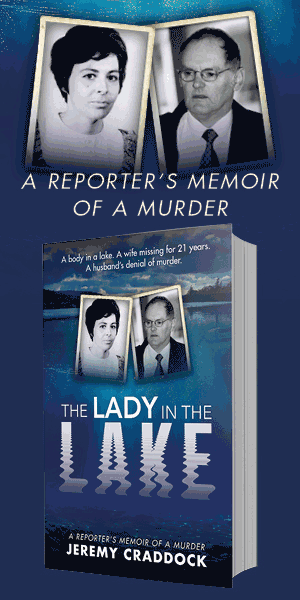The strangest English murder case of the late 20th century
My new true crime book is published today.
It’s called The Lady in the Lake: A Reporter’s Memoir of a Murder and it’s about a terrible case I reported on in 1997 when I was a journalist on the local newspaper in the Lake District.
The mystery was to become, in my view, the strangest English murder case of the late 20th century. In all, it would span five decades before it eventually reached its sad conclusion in 2020.
The book is published today (October 10) by Mirror Books as a paperback and Kindle e-book. It will follow as an audiobook, narrated by Mark Elstob, and published by W. F. Howes Ltd on November 7.
To mark the publication, I’m going to share with you one of the various newspaper features I’ve written to promote the book.
The woman who lay in a watery grave for 21 years
On a warm August day in 1997, three amateur divers broke the surface of Coniston Water, pulling behind them a canvas package trussed up with ropes.
The package was heavy but they managed to drag it on to the shore of the lake. With a knife, one of the divers cut through the outer canvas cover and an inner layer of bin liners. Pieces of lead fell out.
The men recoiled. Inside was a body.
Later that evening, detectives were standing on the edge of the lake. The crime scene was illuminated by high-powered lamps. They peered down at the grim remains of a young woman.
The body was that of Carol Park, a 30-year-old mother-of-three from Barrow-in-Furness in Cumbria in the North of England. She had gone missing 21 years earlier in 1976. The case attracted media attention around the world.

I was a reporter for the local newspaper at the time. As part of the team that reported on the case, I was thrown into the biggest crime story of my career, trying to make sense of the unfolding events.
The case was the strangest English murder mystery of the late 20th century, spanning five decades before justice was finally served. Headline writers, inevitably, labelled the case the Lady in the Lake, borrowing the epithet from Raymond Chandler’s famous crime novel.
Cumbria Police’s chief suspect was Carol Park’s husband Gordon, who was aged 53 in 1997, a retired teacher and married to his third wife. The only problem was, Park was on holiday in France.
Detectives wasted no time in securing a warrant to search Park’s home in Barrow, gaining entry through an upstairs window. Soon after, officers were seen removing computer equipment from the house and rope samples from the garage.
Meanwhile, Park’s children had been informed the body was their mother’s. Two decades of hoping she would return safely were cruelly dashed in an instant.
Carol’s son telephoned his father, Gordon, in France, to break the news. “Oh dear,” was Gordon Park’s reaction to news that his first wife’s body had been found at the bottom of a lake.
The police’s suspicion intensified after Park took four days to return to Barrow. Detectives made their arrest the following morning.
Park had been interviewed by police in 1976 when Carol first disappeared. She had frequently walked out of the marital home and at that time detectives could not be certain she was dead. Without a body, they were powerless.
By the time officers sat down to interview Park in 1997, they had thoroughly done their homework.
Motive
They knew Park had a motive. Gordon and Carol had been unhappily married, both had been unfaithful but had stayed together only for the sake of the children. Park was known to be controlling and coercive.
He also had the wherewithal. He was a keen sailor with a boat on Coniston Water and was a mountaineer proficient in tying knots.
Detectives found Park cold and sarcastic under questioning. He did not present as someone innocent of killing his wife.
Within hours, Park was charged with murder. What might have seemed an open-and-shut case would prove to be one of the most complex and challenging in British legal history.
To the frustration of detectives, the Crown Prosecution Service felt the evidence was not sufficient to go to trial.
In January 1998, the murder charge was dropped. Park wasted no time in trying to restore his reputation. The Mail on Sunday paid him £50,000 for an interview published 10 days later in which he taunted the police.
“I want her murderer caught. After all I’ve been through, the police owe it to me,” Park said.
I saw first-hand Park’s cold demeanour when I reported on Carol’s inquest in 1998. I observed him when the coroner issued a warning to whoever was responsible for Carol’s death: “I hope that their conscience is troubling them.”
Gordon Park showed no emotion.
As the 1990s melted into the new millennium, Cumbria Police never gave up hope of securing a conviction.
It would take another two decades to reach its conclusion, not least because of Gordon Park’s insistence of his innocence and the eroding effect of time on the evidence.
This is a case I could never forget.
Murder
My first true crime book, The Jigsaw Murders, detailed a landmark case from the 1930s. It was a case that saw new forensic and policing techniques developed, many of which are still in use today, 90 years on. That had been challenging as first-hand witnesses were all dead. Now, a book about a modern-day case, with ethical and sensitivity issues to consider, brought a new set of challenges
I researched the contemporary newspaper reports of the time and I conducted fresh interviews with witnesses and experts who had been there. I spoke to the Cumbrian detective who was first on the scene, to the coroner who conducted Carol Park’s inquest and to forensics experts. I also approached surviving members of Gordon and Carol Park’s families.
The Lady in the Lake is a book about a notorious murder case. But it is much more than that. It is a book about a now-bygone era of newspaper journalism and it is a book about the process of writing true crime and its attendant risks.
In writing this book, I also had to examine my own life and experiences. I was a child growing up in the Lake District when Carol Park disappeared in 1976. My parents were similar in age to Gordon and Carol Park. They were a family not so very different from my own.
Yes, this is a book about murder. But it is also a book about families, of mothers and fathers and the passage of time.
The outcome of the case and the fate of Gordon Park is well documented in the public record. But I hope readers will find the narrative style allows them to experience the story as if for the first time, with all the mystery and suspense of a good crime thriller.





Congratulations Jeremy!